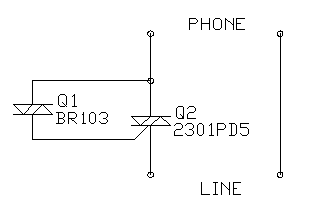
Design and copyright by Tomi Engdahl 1996
This circuit is a simple circuit which prevents picking up other telephone when one telephone is in use. This can be done easily by installing this type of circuit between any telephone and the telephone line.
This type of function is very useful when you don't want other people from disturbing your modem connection or listening to your telephone calls by picking up other telephone connected to same line.
The idea of the circuit is to sense the voltage in the telephone line when the telephone is picked up. If that voltage is higher than about 30V (normal on-hook voltages is about 48V) then the circuit lets the telephone to work normally. If the voltage is lower 30V it prevents the current from going to telephone line to telehone (normally the voltage in line is about 6-10V when one telephone is off-hook). The circuit is designed so that is passes the ring voltage to all telephones without problems.
The circuit is very simple circuit built from one DIAC and one TRIAC. When telephone is picked up it will not get any operating current unless the TRIAC Q2 in series with telephone conducts. The triggering of the TRIAC Q2 is done through DIAC Q1, which will trigget the triac if there is more than about 30V voltage between TRIAC Q2 leads connected to telephone line wires. When TRIAC Q2 start to conduct it will conduct as long as there is any current flowing through it. So TRIAC Q2 conducts until the the telehone handset is put on-hook (call has ended).
This circuit is very similar to the operation of commercial adapters, but remeber that this adapter is not type approved for connection to public telephone network. The component values are just what I used in my prototype and you can replace that triac with nearly any type which will handle atleast 200V, can be triggered easily and keeps on conducting at currents as low as 15 mA.
The drawing below shows how to wire the circuit components and the whole circuit to the telephone line.
I saw one article in sci.electronics.design which mentioned that an article in Elektor Electronics Dec/93 described a similar circuit idea. They used the following components:
Q1 BR100 Q2 TIC106D
NOTE: The pinout of TIC206D is different than the one used in the original circuit, so the component connection drawing is different. No wiring drawing of this modified version is available.
AuVIP (adams@auvip.net.au) has sent me the following comments on
this circuit to me (put here with permission):
"It works. I'm in Australia and it works very well.
Components were either readily available or easily able to be substituted.
Especially the TRIAC."
There is one commercion single component designed to do the same as Q1 and Q2 in my circuit. That component is HS20 bilateral silicon switch which consists of zener diode and triac intergrated to same component. A telephone privacy adapter circuit using HS20 has been shown in Electronics Now and Poptronics magazines and that circuit is very simple because that two wire HS20 component is just wired in series with one of the telephone line wires. I have never tested HS20 component, so I can't tell how well it works but I believe that the circuit works because it is published in two magazines. According Poptronics magazine HS20 bilateral switch can be bought for around $4 from:
SolarWorks Grandprarie TX75052According some usenet articles the HS-20 DIACs which are just about impossible to find and they might be discontinued.
Huw Finney mentioned me that the circuit would work also by using just one normal DIAC in seris with the telephone and not usign any extra components. I have not personally tried it, but with suitable DIAC that might work.
Most diacs are used for pulse generation, probably in the order of amps, and are designed as such. I think the published ratings for static (DC) use are a bit on the consevative side, take a 1N4148 sized diac and say 100 to 200 mW dissipation and about 2V across the diac we are left with 50 to 100 mA, more than enough!
So in engineering sense it seems that just only a DIAC seems to be 'good enough' for this application. I have not personally tested this alternative, but this might be a worth to try.
If you rellay need this type of circuis for everyday use I recommend buying a type-approved commercial unit. If you live in Finland and want to buy a ready made commercial unit, go to a shop which sells telephone accessories and ask for PrivaPhone. This commercial unit will cost about 50 Finnish marks (a little over $10). Aastra Telecom makes also quite similar product BusyLine Switch which has also some extra features.